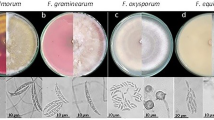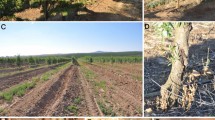Abstract
A SERIOUS soil-borne wilt disease of peas has been shown to be caused by Fusarium oxysporum f. pisi (Linf.) Synder and Hansen, and Fusarium oxysporum Fr. emend. Synder and Hansen var. redolens (Wollenw.) Gordon1,2. Both these fungi attack the vascular system of the plant, and a typical internal symptom of the disease is an orange or brick-red discoloration of the vascular tissue.
This is a preview of subscription content, access via your institution
Access options
Subscribe to this journal
Receive 51 print issues and online access
$199.00 per year
only $3.90 per issue
Buy this article
- Purchase on Springer Link
- Instant access to full article PDF
Prices may be subject to local taxes which are calculated during checkout
Similar content being viewed by others
References
Buxton, E. W., and Storey, I. F., Plant Pathol., 3, 13 (1954).
Buxton, E. W., Trans. Brit. Mycol. Soc., 38, 309 (1955).
Hayward, H. E., “The Structure of Economic Plants”, 350 (The Macmillan Co., New York, 1938).
Author information
Authors and Affiliations
Rights and permissions
About this article
Cite this article
HEPPLE, S. Infection of Peas by Wilt Disease Fungi. Nature 185, 333–334 (1960). https://doi.org/10.1038/185333a0
Issue Date:
DOI: https://doi.org/10.1038/185333a0
This article is cited by
-
The Elegans fusaria causing wilt disease of carnation. I. Taxonomy
Netherlands Journal of Plant Pathology (1988)
Comments
By submitting a comment you agree to abide by our Terms and Community Guidelines. If you find something abusive or that does not comply with our terms or guidelines please flag it as inappropriate.



